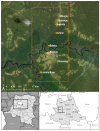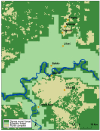Assessing Monkeypox Virus Prevalence in Small Mammals at the Human-Animal Interface in the Democratic Republic of the Congo
- PMID: 28972544
- PMCID: PMC5691634
- DOI: 10.3390/v9100283
Assessing Monkeypox Virus Prevalence in Small Mammals at the Human-Animal Interface in the Democratic Republic of the Congo
Abstract
During 2012, 2013 and 2015, we collected small mammals within 25 km of the town of Boende in Tshuapa Province, the Democratic Republic of the Congo. The prevalence of monkeypox virus (MPXV) in this area is unknown; however, cases of human infection were previously confirmed near these collection sites. Samples were collected from 353 mammals (rodents, shrews, pangolins, elephant shrews, a potamogale, and a hyrax). Some rodents and shrews were captured from houses where human monkeypox cases have recently been identified, but most were trapped in forests and agricultural areas near villages. Real-time PCR and ELISA were used to assess evidence of MPXV infection and other Orthopoxvirus (OPXV) infections in these small mammals. Seven (2.0%) of these animal samples were found to be anti-orthopoxvirus immunoglobulin G (IgG) antibody positive (six rodents: two Funisciurus spp.; one Graphiurus lorraineus; one Cricetomys emini; one Heliosciurus sp.; one Oenomys hypoxanthus, and one elephant shrew Petrodromus tetradactylus); no individuals were found positive in PCR-based assays. These results suggest that a variety of animals can be infected with OPXVs, and that epidemiology studies and educational campaigns should focus on animals that people are regularly contacting, including larger rodents used as protein sources.
Keywords: habitat analysis; human–animal interface; monkeypox; orthopoxviruses; serology; small mammals; wildlife.
Conflict of interest statement
The authors declare no conflict of interest. This research was supported by the National Institutes of Health grant 1R01TW008859-01 (“Sylvatic Reservoirs of Human Monkeypox”). Use of trade, firm, or product names is for descriptive purposes only and does not imply endorsement by the United States Government. The findings and conclusions in this report are those of the authors and do not necessarily represent the views of the Centers for Disease Control and Prevention. The funders had no role in study design, data collection and analysis, decision to publish, or preparation of the manuscript.
Figures





References
-
- Magnus P.V., Andersen E.K., Petersen K.B., Birch-Andersen A. A pox-like disease in cynomolgus monkeys. Acta Pathol. Microbiol. Scand. 1959;46:156–176. doi: 10.1111/j.1699-0463.1959.tb00328.x. - DOI
MeSH terms
Substances
Grants and funding
LinkOut - more resources
Full Text Sources
Other Literature Sources
Medical
Miscellaneous

